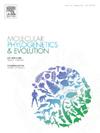内源习性驱动了Appalachian Lathrobium Gravenhorst(鞘翅目,葡萄球菌科)的隐多样性。
IF 3.6
1区 生物学
Q2 BIOCHEMISTRY & MOLECULAR BIOLOGY
引用次数: 0
摘要
南部阿巴拉契亚山脉是一个生物多样性的地区,具有高度的地方性。在共同分布但独立的分类群之间共享的生物地理模式可能阐明阿巴拉契亚地区特有的共同驱动因素。Lathrobium是一个全北极属,在北美有38种,其中6种是不会飞的,是阿巴拉契亚山脉特有的。我们使用一个完整的形态学和多位点分子数据集来研究Appalachian Lathrobium的系统发育和生物地理关系,并测试亚属假设。基于来自67个分类群的176个样本的系统发育支持了三次在阿巴拉契亚山脉的独立到达。在BEAST2中估计的三个谱系的分化时间是同步的,并且在中新世和上新世早期之间(16.4 - 4.6 Ma)。阿巴拉契亚山脉的物种形成发生在更新世(2.3 - 0.1 Ma)。除Abletobium Casey外,现有亚属均支持单系性。Abletobium与glytomerus myller同义。我们的研究结果揭示了阿巴拉契亚山脉寒冷气候避难所对地方性内源分类群的持久性和原位多样性的重要性。我们假设中新世的干旱气候驱使Lathrobium谱系进入山区,随后在温暖的更新世间冰期在山顶避难的隔离导致了物种形成。本文章由计算机程序翻译,如有差异,请以英文原文为准。

Endogean habits drove cryptic diversification in Appalachian Lathrobium Gravenhorst (Coleoptera, Staphylinidae)
The southern Appalachian Mountains are a biodiverse region with high levels of endemism. Shared biogeographic patterns among co-distributed, but independent taxa might illuminate common drivers of Appalachian endemism. Lathrobium is a Holarctic genus with 38 species described form North America, six of which are flightless and endemic to the high Appalachians. We use an integrative morphological and multi-locus molecular dataset to study phylogenetic and biogeographical relationships of Appalachian Lathrobium and test subgeneric hypotheses. A phylogeny based on 176 samples from 67 taxa supported three independent arrivals in the Appalachian Mountains. Divergence times estimated in BEAST2 were concurrent for all three lineages and fell between the Miocene or early Pliocene (16.4 – 4.6 Ma). Speciation within Appalachians occurred during the Pleistocene (2.3 – 0.1 Ma). Monophyly of existing subgenera was supported except for Abletobium Casey. Abletobium is placed in synonymy with Glyptomerus Müller. Our results reveal the importance of cold-climate refugia within the Appalachian Mountains for the persistence and in-situ diversification of endemic endogean taxa. We hypothesize that the xeric climate of the Miocene drove Lathrobium lineages into the mountains and subsequent isolation in mountaintop refugia during warm Pleistocene interglacials led to speciation.
求助全文
通过发布文献求助,成功后即可免费获取论文全文。
去求助
来源期刊
CiteScore
7.50
自引率
7.30%
发文量
249
审稿时长
7.5 months
期刊介绍:
Molecular Phylogenetics and Evolution is dedicated to bringing Darwin''s dream within grasp - to "have fairly true genealogical trees of each great kingdom of Nature." The journal provides a forum for molecular studies that advance our understanding of phylogeny and evolution, further the development of phylogenetically more accurate taxonomic classifications, and ultimately bring a unified classification for all the ramifying lines of life. Phylogeographic studies will be considered for publication if they offer EXCEPTIONAL theoretical or empirical advances.

 求助内容:
求助内容: 应助结果提醒方式:
应助结果提醒方式:


